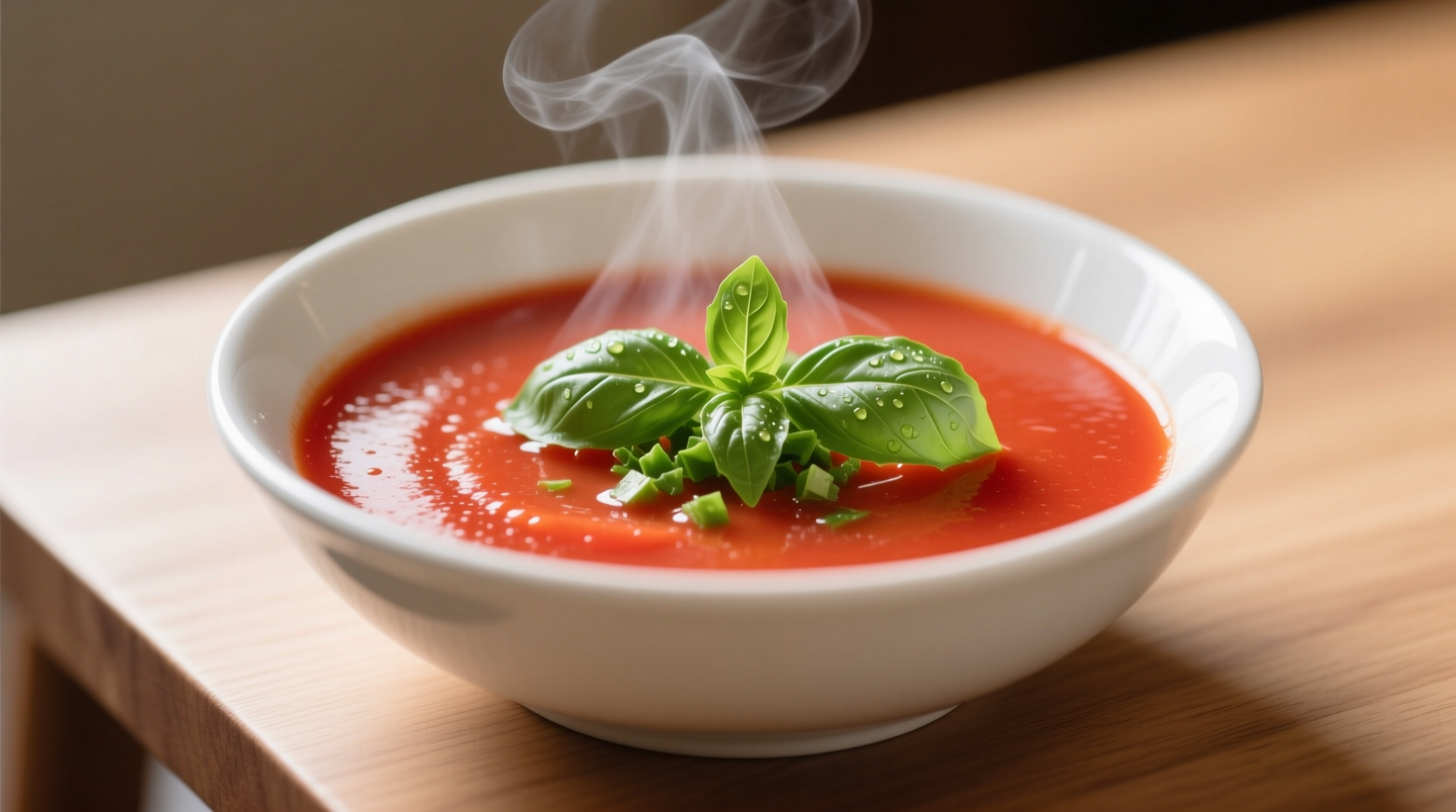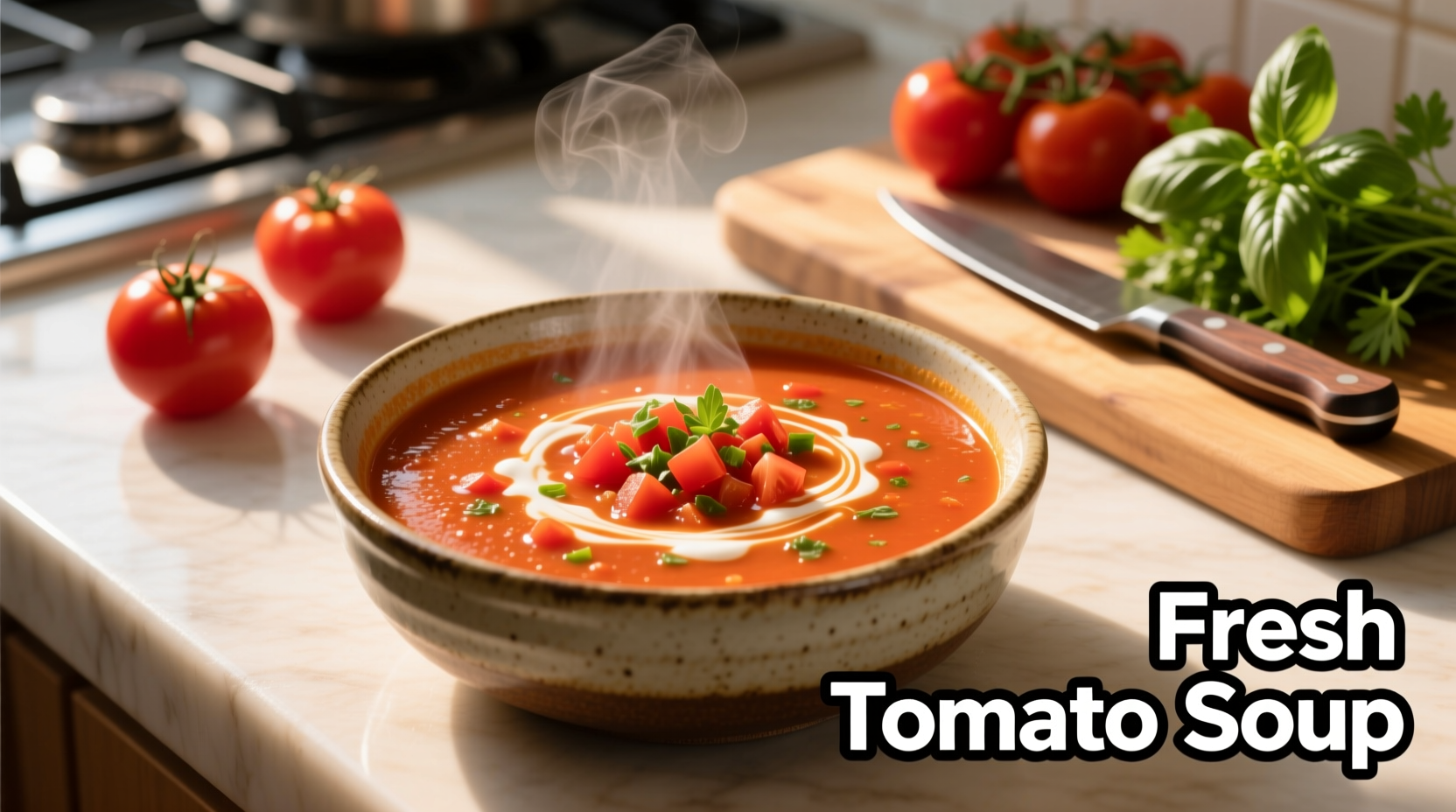Make exceptional tomato soup using fresh tomatoes with this professional chef-tested method. You'll need ripe tomatoes (3-4 lbs), onion, garlic, olive oil, broth, and basic seasonings. The key steps involve selecting peak-season tomatoes, proper roasting technique to concentrate flavors, and balancing acidity for a rich, velvety texture without canned tomato aftertaste. This recipe yields 4 servings in 90 minutes with simple equipment.
There's nothing quite like the vibrant flavor of tomato soup made from garden-fresh tomatoes at their seasonal peak. As a chef who's cooked with tomatoes across three continents, I've discovered that fresh tomato soup surpasses canned versions in both nutritional value and complex flavor profiles. The secret lies not just in the ingredients, but in understanding tomato varieties and proper cooking techniques that preserve their delicate balance of sweetness and acidity.
When you make tomato soup using fresh tomatoes, you're not just creating a meal—you're capturing summer's essence in a bowl. Unlike canned alternatives that often contain preservatives and lack nuanced flavor, fresh tomato soup delivers brighter color, cleaner taste, and higher vitamin C content. This guide reveals professional techniques that solve common fresh tomato soup challenges like watery consistency and inconsistent flavor.
Choosing the Perfect Tomatoes for Soup
Selecting the right tomatoes makes or breaks your soup. Not all varieties work equally well in cooked applications. While grocery stores offer year-round options, peak-season tomatoes from July through September deliver dramatically superior flavor and texture for soup making.
| Tomato Variety | Best For Soup? | Flavor Profile | Seasonality |
|---|---|---|---|
| Roma/Plum | ★★★★★ | Rich, concentrated, low moisture | Mid-summer to early fall |
| Beefsteak | ★★★☆☆ | Sweet but watery, requires reduction | Peak summer |
| Cherry | ★★★☆☆ | Intensely sweet, best blended with others | Late summer |
| Heirloom | ★★☆☆☆ | Complex but inconsistent, fragile | Mid to late summer |
According to USDA agricultural research, Roma tomatoes contain 20% less water content than beefsteak varieties, making them ideal for soup without excessive reduction time. Look for tomatoes that feel heavy for their size with smooth, unblemished skin. Avoid refrigeration before cooking, as cold temperatures degrade flavor compounds—a finding confirmed by Cornell University's food science department (foodscience.cals.cornell.edu).
Essential Equipment for Fresh Tomato Soup
You don't need specialized gear, but these tools make the process smoother:
- Heavy-bottomed Dutch oven (prevents scorching during reduction)
- Immersion blender (safest for hot soup)
- Food mill (removes skins and seeds efficiently)
- Microplane grater (for fresh herb incorporation)
Step-by-Step Fresh Tomato Soup Recipe
This professional technique maximizes flavor while solving common fresh tomato soup problems. Yields 4 servings.
Ingredients
- 3 lbs ripe Roma tomatoes, cored and quartered
- 1 large yellow onion, diced
- 4 garlic cloves, minced
- 2 tbsp extra-virgin olive oil
- 2 cups vegetable broth (low sodium)
- 1 tsp sugar (optional, balances acidity)
- ¼ cup fresh basil, chiffonade
- Salt and freshly ground black pepper to taste
Preparation Process
- Prep tomatoes: Place quartered tomatoes on baking sheet, drizzle with 1 tbsp olive oil, and roast at 400°F (200°C) for 30 minutes. This concentrates flavors and breaks down cell structure.
- Sauté aromatics: In Dutch oven, heat remaining oil over medium heat. Cook onions until translucent (8 minutes), then add garlic and cook 1 minute until fragrant.
- Combine and simmer: Add roasted tomatoes (with juices) and broth. Bring to gentle simmer and cook uncovered for 25 minutes, stirring occasionally.
- Blend smoothly: Use immersion blender directly in pot until completely smooth (or carefully transfer to countertop blender).
- Final seasoning: Pass through food mill if desired smoother texture. Stir in basil, then adjust salt, pepper, and optional sugar to balance acidity.

Troubleshooting Common Fresh Tomato Soup Issues
Unlike canned tomato soup recipes, fresh versions present unique challenges. Here's how to solve them:
Problem: Soup is too watery
Solution: Simmer uncovered longer to reduce liquid. Roasting tomatoes first removes 30% of their water content naturally. Avoid adding excess broth—start with 1½ cups and add more only if needed.
Problem: Bland or acidic flavor
Solution: Taste before final seasoning. Underripe tomatoes often need ½ tsp sugar to balance acidity. For depth, add 1 tbsp tomato paste during sauté step. A splash of balsamic vinegar (¼ tsp) enhances umami without making soup sweet.
Problem: Separation or grainy texture
Solution: Blend while hot but not boiling. For ultra-smooth texture, pass through fine-mesh sieve after blending. Adding 1 tbsp butter at the end creates emulsion that prevents separation.
Seasonal Considerations for Fresh Tomato Soup
Tomato quality varies dramatically by season, affecting your soup's outcome. Understanding these patterns helps you adjust techniques:
- July-August: Early season tomatoes may lack full sweetness. Compensate with 1 tsp honey and longer roasting time.
- September: Peak flavor tomatoes require minimal seasoning. Focus on preserving their delicate balance.
- Off-season: If using winter tomatoes, add ½ cup roasted red peppers for depth and sweetness.
Food science research shows that tomatoes harvested at peak ripeness contain up to 50% more lycopene than vine-ripened grocery store varieties (www.ars.usda.gov). This powerful antioxidant becomes more bioavailable when cooked with healthy fats like olive oil—making your soup both delicious and nutritious.
Serving and Storage Tips
For best flavor development, make soup one day ahead—flavors deepen overnight. Store in airtight container in refrigerator for up to 4 days or freeze for 3 months. When reheating, add a splash of broth if needed to restore consistency.
Pair with crusty bread for dipping or grilled cheese sandwiches. Elevate with fresh basil, a drizzle of basil oil, or a dollop of mascarpone. For elegant presentation, serve in pre-warmed bowls to maintain optimal temperature.
Flavor Variations to Try
Once you've mastered the basic technique, experiment with these professional variations:
- Roasted Garlic Tomato Soup: Add 1 whole roasted garlic bulb during blending
- Tomato Basil Soup: Double the fresh basil and add 1 tsp lemon zest
- Smoky Tomato Soup: Include ½ tsp smoked paprika and roast tomatoes at 425°F
- Creamy Tomato Soup: Blend in ¼ cup coconut milk (dairy-free option) or heavy cream
Nutritional Benefits of Fresh Tomato Soup
Homemade fresh tomato soup provides significant nutritional advantages over canned versions. A single serving delivers:
- 60% of daily vitamin C needs (higher than canned due to no heat processing loss)
- 40% of daily vitamin A requirements
- Significant lycopene content, enhanced by olive oil and cooking
- No added preservatives or sodium (control your salt content)
The National Institutes of Health confirms that lycopene absorption increases by 250% when tomatoes are cooked with healthy fats (www.nih.gov). This makes your homemade soup not just delicious but a powerful antioxidant-rich meal.











 浙公网安备
33010002000092号
浙公网安备
33010002000092号 浙B2-20120091-4
浙B2-20120091-4